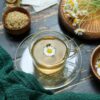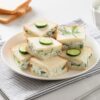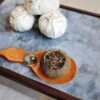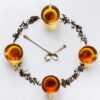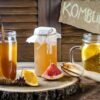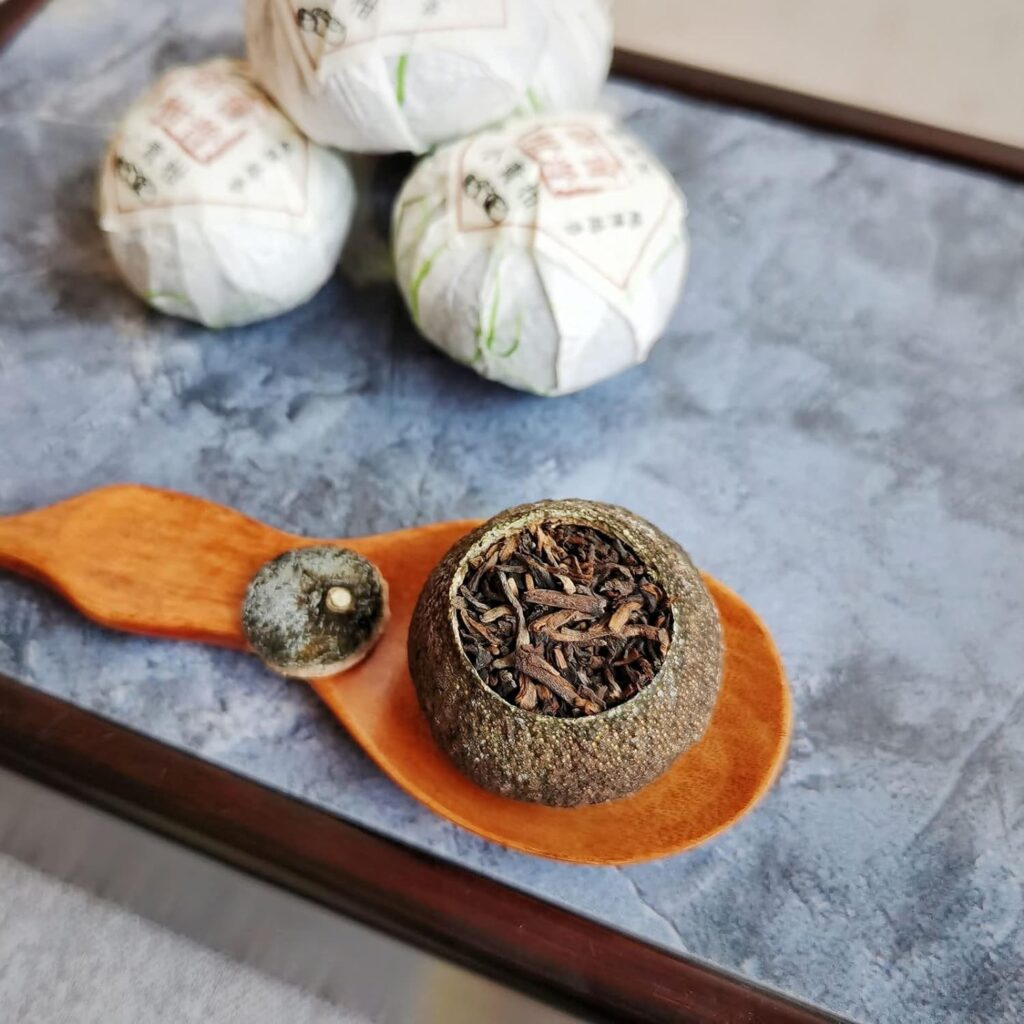
The Xinhui mandarin, a citrus delight heralded for its sweet fragrance and robust flavor, has long been a prized fruit in the Guangdong Province of China. These mandarins are not just a fruit to be consumed; they have transcended into a culinary and cultural phenomenon, particularly when coupled with the ancient art of tea making. This unique marriage of citrus and tea is most profoundly expressed in the creation of Ganpu, a term that refers to Puer tea stuffed into dried Xinhui mandarin oranges.
This craft is more than just a fusion of flavors; it’s a testament to the ingenuity of traditional Chinese tea culture. Each component brings its own set of characteristics to the table, with the Xinhui mandarins providing an invigorating zest and the Puer tea offering its deep, earthy tones. Together, they create a sensory experience that is both complex and harmonious.
Embarking on the journey to understand Ganpu is to delve into a world where aroma and taste converge. The dried peel of the mandarin, known as Chenpi, becomes a vessel for the Puer tea, allowing the tea leaves to absorb the citrus oils during the aging process. This results in a beverage that not only tantalizes the taste buds but also offers a bouquet of health benefits.
History and origin of tea oranges
The tradition of stuffing tea into dried mandarin oranges dates back to the Qing Dynasty, where it was discovered that the marriage of these two ingredients produced a flavor that was greater than the sum of its parts. The people of Xinhui, with their abundant harvest of mandarins, began experimenting with storing tea inside the hollowed-out fruit. The result was an aromatic infusion that captivated the palates of tea enthusiasts.
The historical significance of this practice is deeply woven into the social fabric of the region. Tea artisans would carefully select the finest mandarin oranges at the peak of their ripeness, hollow them out, dry them, and fill them with Puer tea leaves. The stuffed mandarins were then left to age, allowing the tea to ferment and the citrus oils to permeate the leaves.
This process was not only an exercise in patience but also a celebration of the natural resources available in the Xinhui region. The technique has been passed down through generations, with each iteration refining and perfecting the craft. It’s a piece of living history that continues to evolve, yet remains true to its roots.
The unique aroma of Xinhui Mandarins
The Xinhui mandarins are renowned for their unparalleled scent, which is characterized by a rich bouquet that captures the essence of the sun-soaked terroir of the region. The aroma is not just a mere byproduct of the fruit; it’s the signature of the Xinhui mandarin, a distinctive feature that sets it apart from other citrus varieties.
These mandarins contain a high concentration of essential oils in their rind. When dried to become Chenpi, these oils intensify, offering a potent fragrance that is at once sweet, tangy, and refreshing. The scent is complex, with hints of floral and herbal notes that make it a perfect complement to the robust profile of Puer tea.
The Xinhui mandarins’ aroma plays a crucial role in the creation of Ganpu. As the Puer tea leaves are nestled within the dried mandarin peel, they begin to absorb the essential oils. This slow, natural infusion process allows the tea to take on the citrus fragrance, creating a tea that not only tastes incredible but also boasts an aroma that is nothing short of enchanting.
The process of making Puer tea oranges
The artistry behind making Puer tea oranges is a meticulous process that requires precision and care. The first step involves selecting the finest Xinhui mandarins, which are then carefully hollowed out by hand to ensure that the peel remains intact. This outer shell will serve as the container for the Puer tea leaves.
Once hollowed out, the entire fruit peel is placed in a controlled environment to dry, either in the sun or a dehydrator. This drying process is crucial as it allows the peel to harden. After the peel has dried, it is filled with Puer tea leaves.
The final step in creating Puer tea oranges is aging. The stuffed mandarins are stored in a cool, dry place, where they can age for several months or even years. This aging process allows the flavors and aromas to develop depth and complexity, resulting in a tea that is rich, aromatic, and full of nuance.
Health benefits of Chenpi and Puer tea
The combination of Chenpi and Puer tea is not only a delight for the senses but also a boon for health. Chenpi, the dried peel of the Xinhui mandarin, is rich in antioxidants and has been used in traditional Chinese medicine for centuries. It is believed to aid digestion, reduce phlegm, and improve circulation. Its high content of vitamin C and dietary fiber also contributes to overall well-being.
Puer tea, on the other hand, is celebrated for its potential to lower cholesterol, aid in weight loss, and promote heart health. It is a fermented tea, which means it contains probiotics that are beneficial for gut health. The combination of Puer tea with Chenpi thus creates a powerful blend that supports the body in multiple ways.
The natural compounds found in both Chenpi and Puer tea have been the subject of various studies, which suggest that they may have anti-inflammatory properties and can help in combating free radicals in the body. This synergistic effect of the two ingredients makes tea oranges not just a gourmet indulgence but a healthy choice as well.
How to select quality tea oranges
When selecting Xinhui mandarins and Puer tea oranges, there are several factors to consider to ensure that you are getting the best quality. For the mandarins, look for fruits that are firm, with a bright color and a fragrant aroma. The skin should be thin and easy to peel, which is indicative of a good Chenpi.
For Puer tea oranges, the appearance of the mandarin peel is important. It should be intact, with a uniform color, and free from mold or blemishes. Additionally, the quality of the Puer tea inside is just as crucial. It should have a rich, earthy scent and a clean taste, without any off-putting flavors.
When choosing tea oranges, also consider the age of the product. Aged tea oranges are often more prized, as the flavors have had time to mature and develop. The source is also important; reputable sellers with knowledge of the product and its origins are more likely to provide a high-quality experience.
Brewing guide: How to brew tea oranges
Brewing tea stuffed into dried mandarin oranges is an art form that requires attention to detail. The first step is to gently break the seal of the mandarin peel to expose the Puer tea leaves inside. It is important to do this carefully to avoid damaging the leaves.
The Puer leaves can then be steeped in hot water, typically around 95°C (203°F), which is the optimal temperature for extracting the flavors without burning the tea. The steeping time varies depending on personal preference, but generally, a few minutes are sufficient for the first infusion. The beauty of Puer tea oranges is that the leaves can be re-steeped multiple times, with each infusion revealing new layers of flavor.
For the best experience, use a clay teapot or a gaiwan, which are traditional Chinese vessels that are ideal for brewing loose-leaf teas. These vessels allow the leaves to expand and the water to circulate, resulting in a more flavorful brew.
Tips for serving tea oranges in a gaiwan
Serving tea oranges in a gaiwan adds an element of elegance and authenticity to the tea-drinking experience. A gaiwan, which consists of a bowl, a lid, and a saucer, is designed for the appreciation of fine teas and is particularly well-suited for Puer tea.
When using a gaiwan, it is important to pre-warm the vessel with hot water before adding the tea leaves. This ensures that the temperature remains consistent throughout the brewing process. The lid of the gaiwan can be used to gently agitate the leaves, releasing the full spectrum of flavors and aromas.
Pouring the tea from a gaiwan requires a steady hand and a bit of practice. The lid is slightly tilted to act as a filter, holding back the leaves while the liquid is poured into cups. This method allows for a clear, unobstructed view of the tea’s color and ensures a smooth, sediment-free pour.
Where to buy tea oranges
For those seeking to purchase Xinhui mandarins and Puer tea oranges, there are several options available. Specialty tea shops, both brick-and-mortar and online, often carry a selection of tea oranges. These retailers typically source their products directly from the Xinhui region, ensuring authenticity and quality.
When shopping online, it is advisable to read reviews and research the seller’s reputation. Look for vendors who specialize in Chinese teas and who provide detailed information about the origin and production of their tea oranges. Additionally, tea enthusiasts may find these products at Asian markets or through community groups that share a passion for traditional Chinese teas.
The unique experience of stuffed tea oranges
The experience of savoring Xinhui Mandarins in stuffed tea oranges is one that encompasses history, culture, and an exquisite interplay of flavors. The meticulous process of making these tea oranges, coupled with the health benefits and the ritual of brewing, culminates in a beverage that is much more than just a cup of tea. It is an embodiment of tradition and craftsmanship, a journey through the senses, and a testament to the rich heritage of the Xinhui region.
For those who have yet to indulge in this unique tea experience, the blend of sweet, tangy Chenpi and earthy Puer tea awaits. It is an exploration of aroma and taste that promises to leave a lasting impression, an aromatic adventure that beckons to be discovered.

